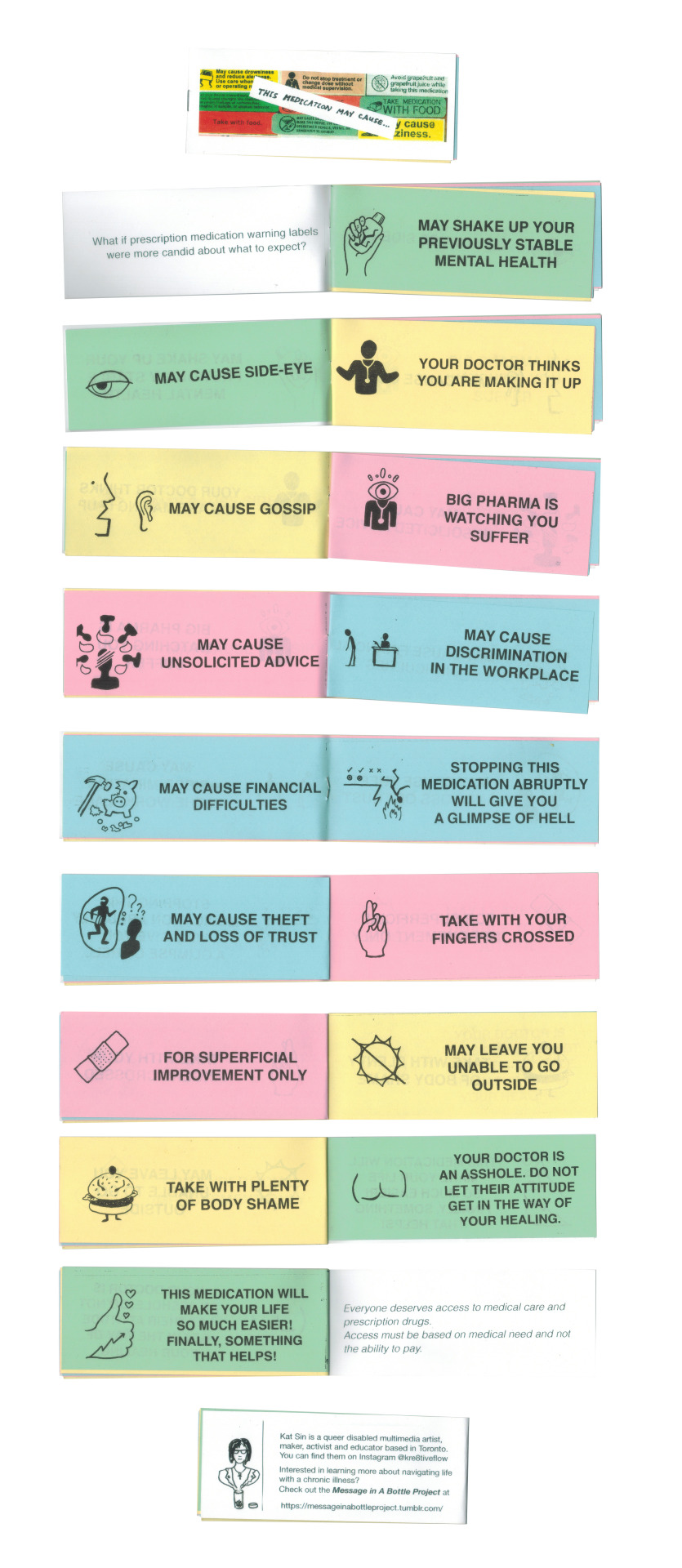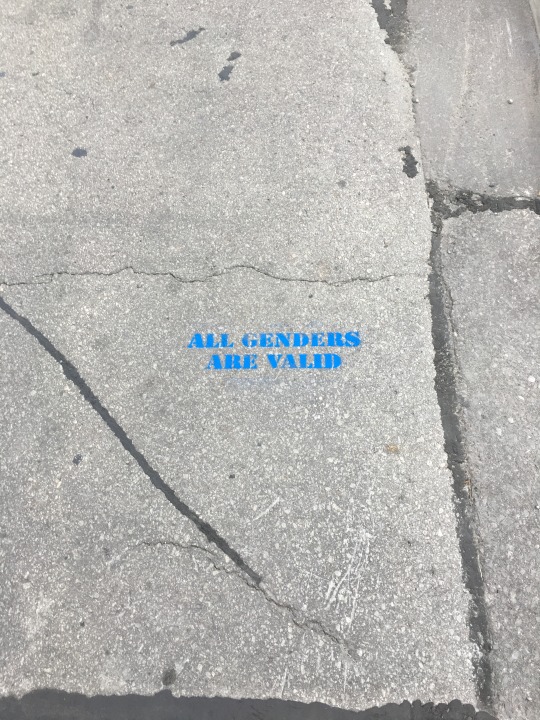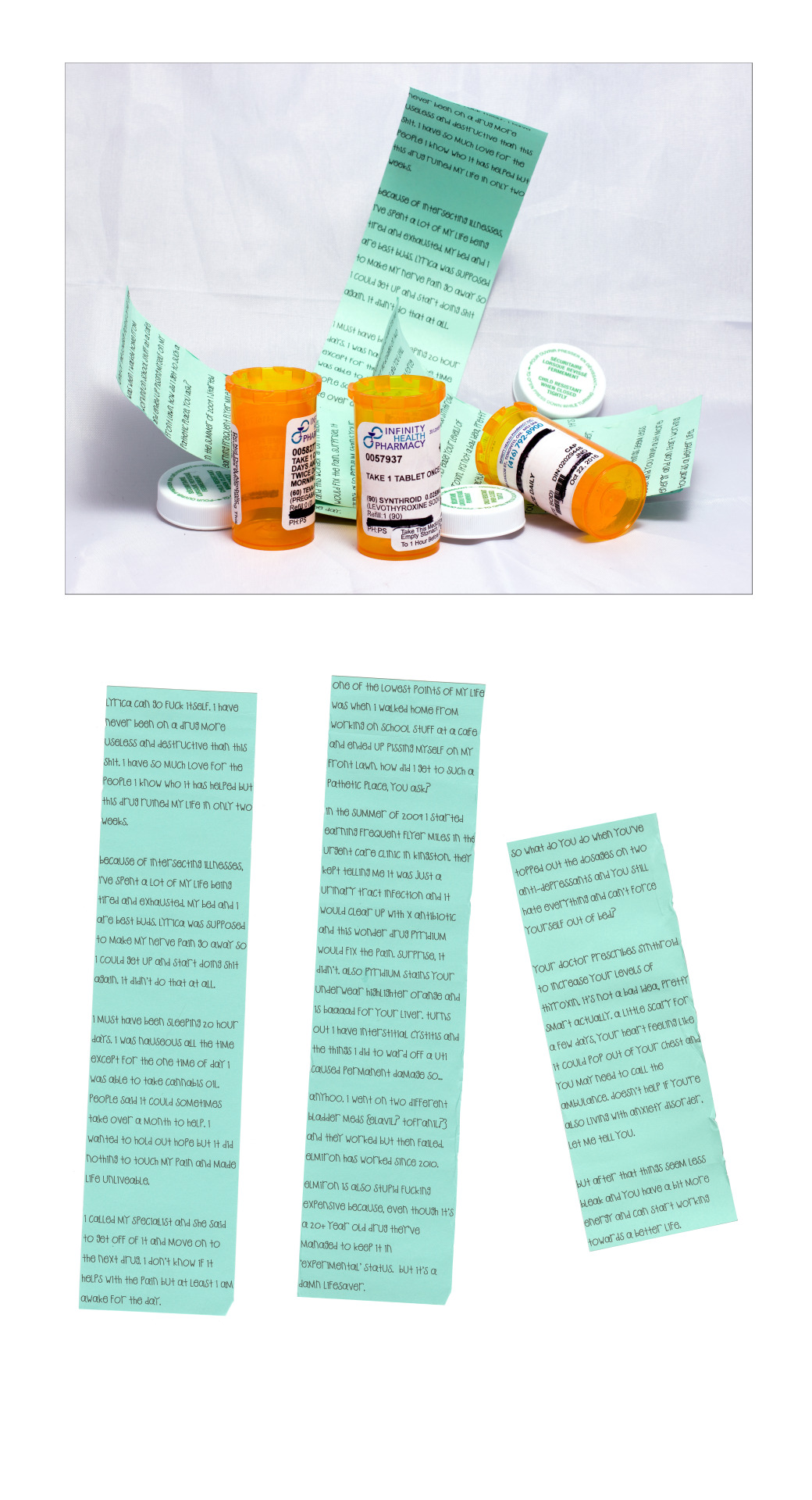#fac2018
Text
MEET THE FAC 2018 RESIDENCY ARTISTS: Katrissa Singer
What, from your life or experiences, has influenced your work most? What do you hope to achieve in your art?
I have always used my art as a means of dissecting and analyzing my experience, so whatever is going on in my life at any given moment is bound to be reflected in what I create.
For the past several years I’ve mainly been making art that speaks to navigating life with chronic illness. I’ve explored this subject from many different angles in a wide range of media. A zine poking fun at prescription medication labels, a large photographic series confronting the embodied experience of being at the mercy of medical institutions, assemblage sculptures out of prescription medicine bottles, t-shirt designs referencing the spoonie subculture, a community-based art project aiming to de-stigmatize prescription medication use, street art encouraging self-compassion, and many other smaller projects came out of this period of discovering, denying, exploring and finally accepting my limitations. I don’t think that “accepting limitations” is the same as “giving up”. It is more about finding different ways to do things, adjusting one’s expectations, reassessing priorities, or allowing oneself to grieve and move on.
Lately I’ve been going through many different transitions simultaneously, and I’m often finding myself in liminal spaces. Sometimes I am finding it hard to adapt to always being in flux, and I yearn for certainty. At other times, being-not-quite-here-but-not-there-yet-either feels perfectly natural and even a bit exciting. This is why right now I am inspired by change and growth. I want to reconcile myself with my past and let go of the baggage that’s been dragging me down. I’ve been reading a lot about the effect trauma has on our minds and bodies, and how it restricts one’s ability to think clearly, feel pleasure and bond with others. And now, more than ever, I am looking to find a way to heal and become whole. Part of this process involves exposing things that haunt me to light. There is something extremely validating in sharing a part of yourself that makes you feel alone and realizing that, in fact, many others can relate. Another part of healing, the one that I am still struggling with, is imagining a future where things are different. I am still very tentative when it comes to making plans, but I am slowly becoming more confident. I am, once again, in the in-between stage, not stuck in the past all the time yet not fully free of its burdens, still afraid to face the future, but planting seeds in the present that will hopefully thrive.
As for what I hope to achieve in my art… that’s a pretty complex question. I create for primarily selfish reasons; art makes me happy. It gives me a voice. It consoles me when nothing else can. It excites me. I am hoping that it will continue to do all these things for me, and also for others. I tell stories through my art, and if these stories help someone feel more present and connected, even for a moment, it brings me joy. I want my art to open minds, even if it sometimes means making someone feel a bit uncomfortable. Several of my projects exploit discomfort to deliver the message: Please Be Patient, for example, that will be featured in the Exposed exhibit at Scotiabank Festival involved getting my models out of their everyday clothes and into a thin paper hospital gown, making a statement about the depersonalization that occurs when individuals face institutions. I want my art to continue doing what it is doing right now, but to do it better. But most of all I wish to be able to continue creating art. I am worried that I won’t be able to afford my art practice for much longer. I am trying to “sneak” art into my future career, and I am hoping I succeed. This year, I joined Workman Arts, and they have been an amazing support. I got some training, exhibition opportunities, a few gigs, and my first grant through them, and I am incredibly grateful that this organization exists.

Can you speak to the variety of materials and methods you use in your art and why you have chosen them?
When I first imagined becoming an artist, I thought I would draw and paint. That’s pretty much what an average person asks me when I say I’m an artist: “What do you paint?” It was pretty heartbreaking for me to realize that while I am competent at both drawing and painting, I’m not in any way outstanding. At some point I gave up on art entirely because I’ve been taught that I will never be successful unless I’m absolutely amazing. I had a very limited view of what doing art can look like, and it took me a while to question where these assumptions came from, deconstruct them and shift my perspective.
Seeing art as a means of achievement rather than of expression was part of this toxic set of beliefs. Part of the process of embracing art as a way of life was discovering new media. You can use pretty much anything to make art. I have always looked up to artists who appear to effortlessly combine disparate elements and create something greater than the sum of its parts. I am drawn to contrast and reconciling the opposites.
When I am immersed in exploring new techniques and materials I get to reconnect with a sense of wonder I feared I’d lost. I allow myself to play. I feed my curiosity. I rediscover my zest for life. The downside to working in multiple media is that sometimes the learning curve is too steep and I can get frustrated and lose interest. The advantage is that I discover - often by chance - ways to transcend limitations of various media and make something that is needed. I am a synaestete, meaning that my sensory perceptions are sometimes blended: I can taste color, see sounds, etc., so engaging with new concepts and materials can be like cooking, except sometimes I set out to make a steak and discover a new flavour of ice cream.
I am also an avid collector of oddities. I found Jesus (a baby from a nativity scene) on the sidewalk once. I love beach combing, and going to thrift stores. I see worth in things others consider to be trash, and I am often inspired by things I find littering the sidewalks. I joke that I can relate to discarded objects, because I too am broken and not very useful. Humor makes it easier to cope with the fact that my existence as an artist is directly at odds with capitalist culture, since my art practice has very little commercial value. I tackle subjects that are often quite unpalatable to the general public, and the images I produce are not the kind you’d find displayed in people’s living rooms. The saying about how art should disturb the comfortable and comfort the disturbed resonated with me deeply, and I often do just that.

In “Message in a Bottle”, you use pill bottles with anecdotes from individuals living with illnesses or disabilities. Is there a significance to the title of this work? Why do you think these stories are important to tell?
Ever since I read about it as a child, I have been fascinated by the idea of putting a message in a sealed container and releasing it into a body of water, hoping that it would someday be found and read. I often daydreamed about being mired on a deserted island, and I would weave elaborate narratives about what I would do to survive and ultimately escape - a pastime many misunderstood loners could probably relate to.
When I was in the final year of my Bachelor of Fine Arts, I found myself feeling increasingly isolated - I was reeling from a cancer scare, a recent breakup, and the death of my cat. The results of the 2016 US Presidential election left me feeling absolutely hopeless: as an immigrant, a non-binary person assigned female at birth, a disabled person - I felt afraid and heartbroken for people south of the border whose lives would be negatively impacted by the change of government. I buried myself in schoolwork to cope, I wanted to feel numb but I just felt sore all over, all the time. One day I was cleaning and I came across a dozen of old medication bottles. They were mostly empty, and many were from medications I wish I hadn’t taken. I wanted to do something with them - make them part of a memorial to misdiagnosis, maybe. I didn’t have enough, so I hit up a few of my friends for empties. Then when someone dropped off an unfinished bottle of the same medication that gave me awful side effects, I wondered if they had experienced similar issues. I reached out to them and sure enough, their experience was similar to mine: the doctor had dismissed their concerns and told them to increase their dosage and come back in a few months. I felt angry. I needed to do something. As much as I felt like it, I couldn’t go yell at my doctor, because it wouldn’t change anything.
I remembered that my friend sounded relieved when I reached out to them and shared my own experience. I asked them if they would be comfortable sharing their experience with others, anonymously, via a handwritten note inside the bottle with a partially peeled off label. They said “yes”, and I put a call for submissions out of social media. I thought I would get maybe ten “bites” and use the bottles and the messages as part of my upcoming exhibit on chronic illness. I had an incredible initial response, however, and received about thirty entries in two months. I ended up scanning the bottles and their contents, and the “Message In a Bottle” series was the main work featured in my first solo exhibit titled “Spoonderland”. Throughout the duration of the exhibit, I had many people contact me, saying that they were profoundly affected by reading the messages. I decided I would continue to accept submissions, hoping to eventually exhibit again. Then I realized that if I were to confine my work to a physical space, many of the people who need to see this material the most would be unable to access it. I started Message in A Bottle Blog online, sharing one entry a week. I was aiming to keep it alive indefinitely; however, it has been difficult to collect submissions in the past six months. I have not shared my own story on the blog yet, because I was hoping to do so on its second anniversary, which is eleven months away. I’ve tried my best to solicit a diverse pool of respondents, but I found that the project had a few “blind spots”: voices of persons of color (especially men), cancer patients, HIV+ individuals and their partners, and people under eighteen and over sixty were conspicuously absent. I realize that there are many reasons for this, but I feel that the project is incomplete and has room to grow. I would like to continue with Message in A Bottle, but I need help. This project was created to break down stigma and give people a safe platform to share their experiences. I truly believe that sharing one’s stories of prescription medication use: the good the bad, and the ugly, can shift the existing power dynamics between doctors and patients by making people better informed about risks and benefits of certain medications and empowering individuals to advocate for themselves when they are in need of medical treatment.
You can find the Message In A Bottle Project Blog here: https://messageinabottleproject.tumblr.com
Message in A Bottle Project is still accepting submissions: https://messageinabottleproject.tumblr.com/guidelines2sub

13 notes
·
View notes